Article
*Unauthorized reproduction is prohibited
May 31, 2023
Wariness of China-Russia Nuclear Cooperation: China May Accelerate Its Nuclear Arms Expansion
Yuki Kobayashi
(Research Fellow, Sasakawa Peace Foundation)
1. Russia Provides China with Highly-Enriched Uranium
Russia’s providing China with a significant amount of highly enriched uranium has created a stir in the international community, with the U.S. Congress demanding that the Biden administration take countermeasures. This is because this may help China accelerate its nuclear arms expansion.
The uranium provided to China is supposed to be used for the fast breeder reactors (FBR) being built in Fujian Province in southeast China. While the FBRs are claimed to be for civilian purposes (for power generation), nuclear reaction in the reactor produces new plutonium, which can be reprocessed to obtain plutonium suitable for weapons.
Sasakawa Peace Foundation’s analysis of satellite images indicates that reactor Unit 1 of this nuclear plant is expected to start operation in 2023. The U.S. Department of Defense is also aware of this development, and a report on military developments in China it submitted to Congress in November 2022 warned that, while China’s current stockpile of nuclear warheads is said to be around 350, “it will likely field a stockpile of about 1,500 warheads by its 2035 timeline”[1]。
Lack of transparency in the transfer of nuclear materials between China and Russia and the resulting increase in China’s plutonium production and nuclear arms expansion will not only heighten tension between the U.S. and China and in the Asian region, but will also emasculate the international regime for controlling nuclear materials under the International Atomic Energy Agency (IAEA) and may result in the collapse of the nuclear order based on the Nuclear Non-Proliferation Treaty (NPT).
This article will first give an overview of the structure of FBRs and look into the background to China’s procurement of a large amount of uranium from Russia. Referring to the minutes of the U.S. Congress, it will also examine the risk of China-Russia nuclear cooperation being linked to China’s nuclear arms expansion. Lastly, it will discuss the impact of China’s nuclear arms expansion on the international community and what response is necessary.
2. The Structure of FBRs and China-Russia Nuclear Cooperation
(1) The Structure of FBRs
FBRs are termed “dream nuclear reactors” because they generate more energy than the amount of injected fuel through reaction that occurs in the reactor as it operates. In concrete terms, uranium fuel or plutonium is loaded into the reactor core. As the core fuel (parts shaded in orange and pink in Figure 1) is combusted over one to four years to generate power, releasing neutrons in the process, part of the surrounding blanket fuel (depleted uranium) is transformed into plutonium. By reprocessing this blanket fuel, a large amount of plutonium-239 with high combustion efficiency can be obtained, which can, in turn, be reused as FBR fuel or converted into nuclear weapons.
Figure 1: Conceptual Drawing of the Fast Breeder Reactor Core
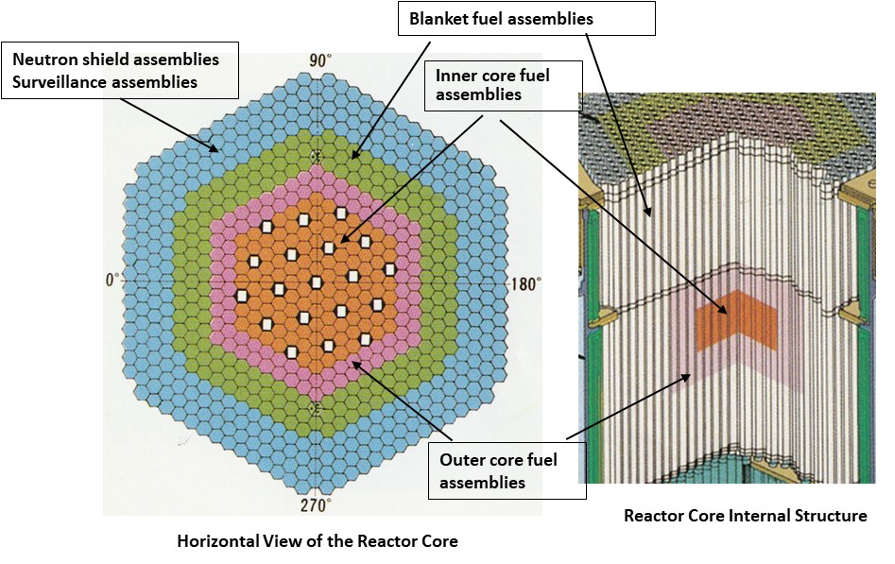
(Provided by Secretary General Tomonori Iwamoto of the Institute of Nuclear Materials Management Japan Chapter)
The U.S., Russia, France, the UK, and Japan were the leaders in the development of FRBs. A prototype reactor, “Monju,”[2] operated in Japan from 1994 to 1995. However, it was found that it is very difficult to manage sodium used for cooling nuclear reactors.
The U.S. terminated its development in the 1980s; the UK and France followed suit in the 1990s; and Japan decided in 2016 to decommission its FBR. However, with Russia’s technical support, China has pushed forward its development, with two large FBRs, called the CFR600 (power output 600,000 kilowatts, or over two times the capacity of Japan’s “Monju”) are scheduled to start operation in 2023 and around 2026.[3] Actually, the satellite image below taken in September 2022 shows that most of the structures of CFR600 Unit 1 appear to have been completed, including the reactor building to house the FBR and the turbine building to generate power by rotating turbines with steam produced by heat from the reactor, indicating operation will start shortly.
Satellite Image 1
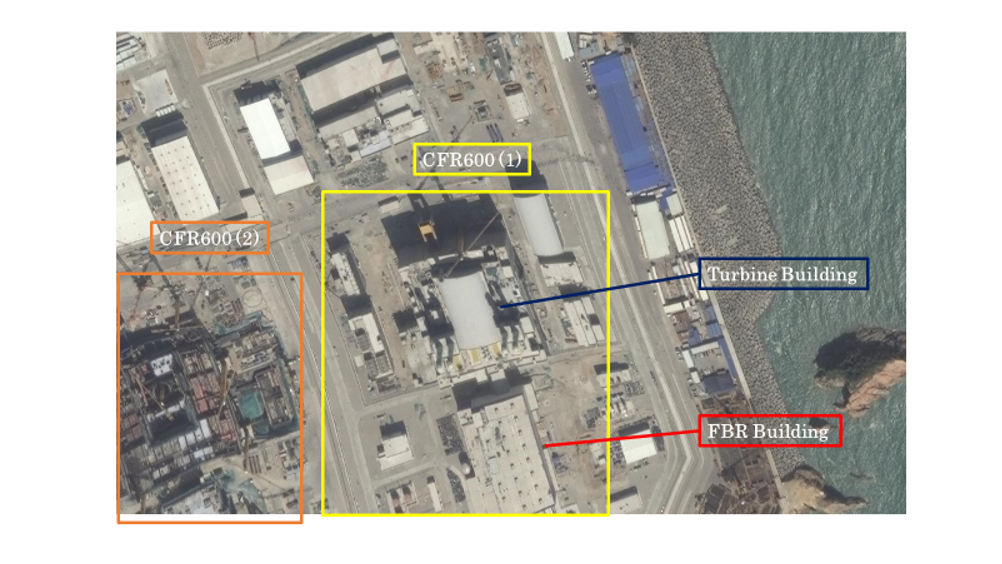
* (C) Maxar Technologies, Inc. Taken on Sept. 30, 2022
Depending on the burnup of the fuel, normally, one-fourth of FBR fuel is replaced each time, but since fuel is loaded all at once at the start of operation, a substantial amount is required. Below is the estimated initial amount of plutonium or uranium fuel needed for the CFR600 to kick off operation calculated based on the initial amount of plutonium loaded into “Monju” (power output 280,000 kilowatts).
According to the English version of the brochure on Monju, initial core fuel loaded was 5.9 tons. It is estimated that approximately 800 kilograms of fissile plutonium (which combusts through nuclear fission), including plutonium-239, was used as core fuel.[4] Since the CFR600 is designed for an output of more than two times that of Monju, it is estimated that some 1.8 tons of fissile plutonium will be needed. On the other hand, if uranium is used as core fuel, around 8.6 tons will be needed. However, uranium fuel for use in FBRs will require special processing, as to be discussed below.
(2) Developments in China’s Uranium Enrichment and Plutonium Production
An analysis of the above required amounts, China’s uranium fuel production technology, and latest developments in its plutonium production points to the reason why China has to rely on Russia for the supply of FBR fuel.
Natural uranium ore contains only 0.7% uranium-235 that can be used as fissile fuel, and 99.3% is uranium-238, which is non-fissile and not usable as fuel for nuclear power generation. For this reason, enrichment processing is necessary to increase the ratio of uranium-235. Uranium 235 and 238 need to be separated little by little by cascading centrifuges for repeated processing. All current light water reactors in the world, including in Japan, use uranium enriched to around 5% uranium-235 content as nuclear fuel. China ranks fourth in the world in the production of enriched uranium used in nuclear reactors. (see Figure 2)
Figure 2: Global Share of Enriched Uranium (2020)
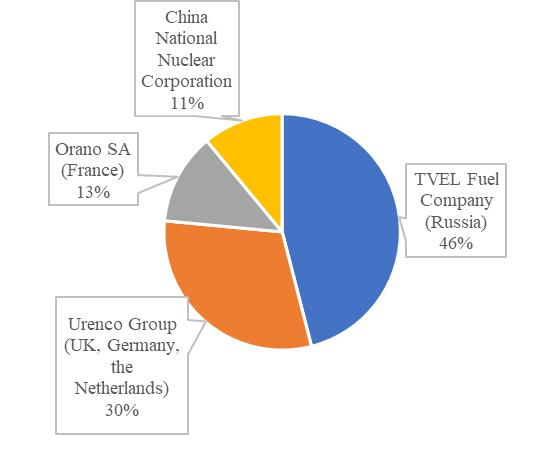
Source: Created by the authors based on “Uran Noshuku Gyokai no Sekai Shijo Shea no Bunseki [Analysis of Global Market Shares of Uranium Enrichment Companies],” (deallab), etc.
However, it is necessary to increase the burnup degree of uranium to use uranium fuel in FBRs, and the concentration of uranium-235 needs to be increased to around 20%. China’s enrichment technology is based on technology transfer from Russia (see Image 1), and this technology is not capable of extracting uranium fuel with a 20% concentration of uranium-235.
Image 1: Russian-made Centrifuges
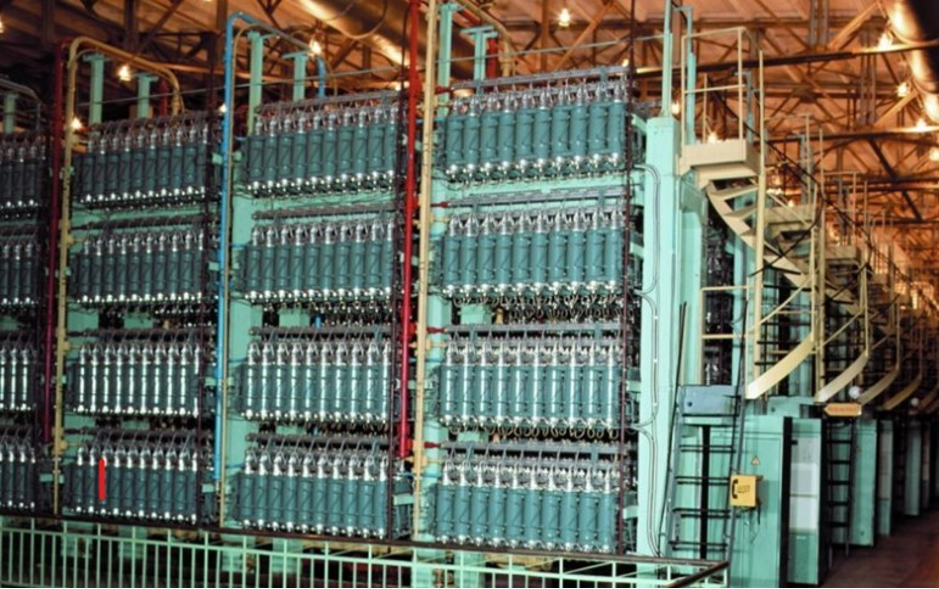
As shown in Figure 3, the process for capturing and retrieving enriched uranium gas is not designed to retrieve enriched uranium with a uranium-235 concentration over 5%.
Figure 3: Uranium Enrichment Process
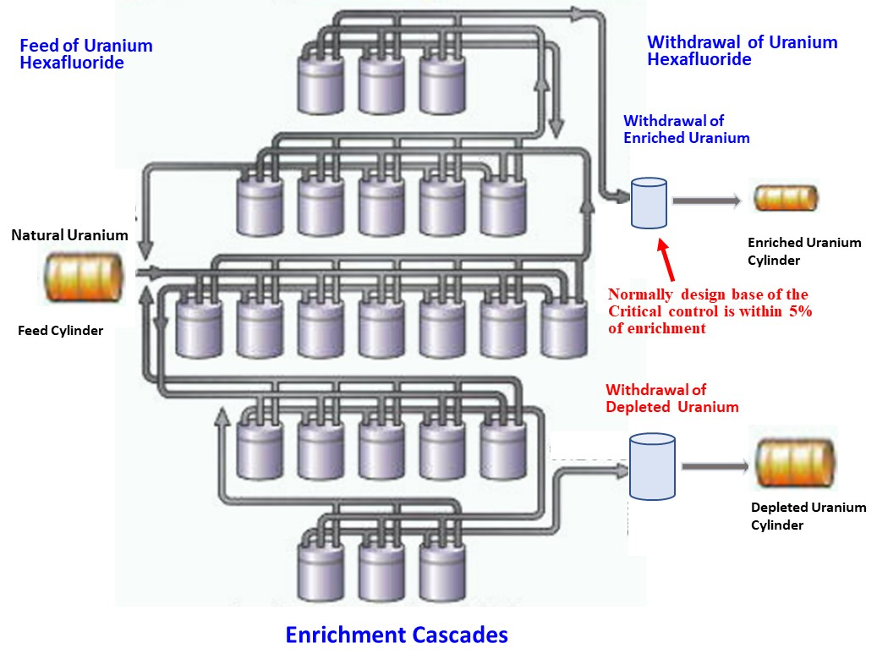
(Provided by Secretary General Tomonori Iwamoto of the Institute of Nuclear Materials Management Japan Chapter)
Moreover, China has accepted IAEA safeguards on this enrichment facility, which proved that it does not produce enriched uranium with a uranium-235 concentration greater than 5%. Uranium enrichment is a technology that may lead to the development of nuclear weapons. Increasing the ratio of uranium-235 to 90% will produce weapons-grade uranium. Theoretically speaking, acquiring the technology for 5% enrichment makes the manufacture of uranium with around 90% uranium-235 concentration possible. While China is recognized under the NPT as a nuclear-weapon state that has no obligation to accept IAEA safeguards, it is reckoned that Russia asked China to accept safeguards to prevent the proliferation of the technology it transferred.
For the above reasons, it is believed that China is unable to achieve self-sufficiency in uranium fuel for FBRs at present.
As to plutonium, China had produced plutonium at a military facility in the inland province of Kansu for many years, but this facility was shut down in 1987.[5] Based on China’s own declaration under IAEA’s “Guidelines for the Management of Plutonium,” its stockpile of plutonium for civilian use was 40.9 kilograms as of 2016.
| Table 1: Guidelines for the Management of Plutonium (China) | |||||||
|---|---|---|---|---|---|---|---|
| Year | 2010 | 2011 | 2012 | 2013 | 2014 | 2015 | 2016 |
| Amount | 13.8 | 13.8 | 13.8 | 13.8 | 25.4 | 25.4 | 40.9 |
| * Created by this author based on “Guidelines for the Management of Plutonium, 2017” | |||||||
It is estimated that China possesses close to 1 ton of weapons-grade plutonium produced at its military facilities. Even combining this with plutonium for civilian use, the amount is still insufficient for the initial operation of FBRs. Furthermore, using its current stockpile of weapons-grade plutonium to produce more weapons-grade plutonium will require a temporary slowdown in its nuclear arms expansion. Therefore, China is unlikely to go for this option.
It is reckoned that in light of its goal to acquire weapons-grade plutonium through the early start of FBR operation and its current uranium enrichment technology and plutonium stockpile, China has decided to obtain the initial fuel for FBR operation from Russia.
3. U.S. Concerns about China’s Increasing Plutonium Production and Nuclear Arms Expansion
(1) The U.S.’s Growing Wariness
The international community is increasingly wary about the deepening China-Russia nuclear cooperation. Assistant Secretary of Defense John Plumb responsible for nuclear arms and space policy at the Pentagon testified at a U.S. House of Representatives hearing in early March 2023: “It's very troubling to see Russia and China cooperating in the nuclear area” because “there's no getting around the fact that breeder reactors are plutonium, and plutonium is for weapons.” He indicated that Russia’s providing uranium to China will facilitate the strengthening of the latter’s nuclear power.[6]
If China’s two CFR600s start operating as scheduled, this alone will give China up to 330+ kilograms of weapons-grade plutonium each year. Since 3.5±0.5 kilograms of plutonium are needed for each nuclear warhead mounted on missiles, this amount is equivalent to 82-110 nuclear warheads. The Nonproliferation Policy Education Center (NPEC), an organization of U.S. non-proliferation experts and former policymakers, while allowing a certain margin in its assessment of the amount of extractable plutonium due to possible technical difficulties, estimates the annual plutonium production by the two FBRs and the accumulated total by 2030 in Table 2 below.
| Table 2: China’s Plutonium Production with FBRs | |||
|---|---|---|---|
| Year | Small FBRs (kg) | 2 CFR-600s (kg) | Total (kg) |
| 2012-2020 | 45-46 | 45-56 | |
| 2021 | 5-7 | 50-63 | |
| 2022 | 5-7 | 55-70 | |
| 2023 | 5-7 | 60-77 | |
| 2024 | 5-7 | 91-164 | 156-248 |
| 2025 | 5-7 | 91-164 | 252-419 |
| 2026 | 5-7 | 91-164 | 348-590 |
| 2027 | 5-7 | 187-337 | 540-934 |
| 2028 | 5-7 | 187-337 | 732-1278 |
| 2029 | 5-7 | 187-337 | 924-1622 |
| 2030 | 5-7 | 192-346 | 1121-1975 |
| * Created by the author based on NPEC, “China’s Civil Nuclear Sector : Plowshares to Swords?” | |||
Together with the amount it is thought to possess at present, China will have 2.9±0.6 tons of weapons-grade plutonium by the end of 2030, equivalent to 830±210 nuclear warheads.[7] The U.S. Defense Department’s analysis cited earlier that China “will likely field a stockpile of about 1,500 warheads by its 2035 timeline” tallies with the projected increase in China’s plutonium production from now on. It is evident that Plumb’s warning was not concerned only with the closer relationship between China and Russia.
(2) Change in China’s Nuclear Strategy with the Increase in the Number of Nuclear Warheads
If the number of China’s nuclear warheads approaches 1,000, this will mean that it is catching up with the number of nuclear weapons deployed by the U.S. and Russia and will eventually overtake these two countries.
| Table 3: Number of Nuclear Warheads in the World (as of June 2021) | ||
|---|---|---|
| Country | Total | Deployed |
| Russia | 6,260 | 1,600 |
| U.S. | 5,550 | 1,800 |
| China | 350 | 0 |
| France | 290 | 280 |
| UK | 225 | 120 |
| Pakistan | 165 | 0 |
| India | 160 | 0 |
| Israel | 90 | 0 |
| North Korea | 40 | 0 |
| Total | 13,130 | 3,800 |
| *Created by this author based on The World's Nuclear Warheads Count, 2021, Research Center for Nuclear Weapons Abolition, Nagasaki University (RECNA). | ||
In which case, China’s nuclear strategy may change.
Since China conducted its first successful nuclear test in 1964, it has pursued a policy of minimum deterrence, i.e., maintaining deterrence by possessing the minimum required retaliatory force to a nuclear attack. In more concrete terms, this means securing the capability to launch counterattacks on major U.S. or Soviet cities with nuclear warheads surviving their first strike. Considering China’s inferior economic power and technological level at that time, this amounted to an “asymmetric equilibrium” that would deter the adversary from using nuclear arms with the capability to counterattack major cities and not a “symmetric equilibrium” that assured the destruction of the adversary with a second strike.[8]
However, after China became the number two economic power in the world, it is striving to increase its number of nuclear warheads, as well as modernizing its weaponry, such as by converting its ballistic missiles into Multiple Independently-targetable Reentry Vehicles (MIRV). It is highly possible that China is beginning to change its policy of minimum deterrence and is aiming to possess the capability to exchange decisive strikes with the U.S. and pursue a balance of power.[9]
4. Impact of Change in China’s Nuclear Strategy and the Required Response
(1) Impact of China’s Nuclear Arms Expansion on the International Community
China’s nuclear arms expansion and change of nuclear strategy may have a serious impact on the international community both militarily and in terms of nuclear non-proliferation. Militarily, it is feared that if China comes to perceive that it has achieved “mutual assured destruction” with the U.S. and is able to deter U.S. intervention in security issues in the Asian region, it may initiate coercive or aggressive actions, including the armed unification of Taiwan and changing the status quo by force.
Russian support for China’s nuclear arms expansion may also impact the U.S.’s nuclear deterrence strategy. The U.S. will have to envision a game with the U.S. on one side and China and Russia on the other, instead of a game in which the U.S., China, and Russia are independent players in mutual deterrence, thus giving the U.S. greater incentive to strengthen its nuclear weapons. The U.S. is now actively promoting the development of new ICBMs, which it had not been keen on in the past. The U.S. Air Force is developing the “Sentinel” to replace the obsolete Minuteman ICBMs with Northrop Grumman and has succeeded in the test fire of the stage-one solid rocket motor this past March.
On the other hand, the U.S. is not eager to rapidly increase the number of its deployed nuclear warheads at present. There is an opinion in the U.S. in favor of an offset strategy that does not rely solely on nuclear weapons, but also employs other means as well. Japan is moving toward integrating its own deterrence efforts with U.S. deterrence under the bilateral security alliance. The U.S.’s adopting an offset strategy will make the equation for deterrence even more complex, and this may also affect how the Japan-U.S. alliance functions.
There will also be a tremendous impact on the nuclear non-proliferation regime. Article 6 of the NPT stipulates that the nuclear-weapon states must “pursue negotiations in good faith on effective measures relating to …nuclear disarmament.” If contrary to the demand of the non-nuclear-weapon states for them to abide by Article 6, the nuclear-weapon states move toward nuclear arms expansion, more countries will secede from the NPT, and there will be a serious risk of deterioration of the NPT-based international nuclear order.
(2) What Must Japan, the U.S., and the International Community Do?
How, then, should Japan and the international community respond to this situation?
The National Defense Strategy approved by the cabinet in late 2022 calls for working with the U.S. to strengthen deterrence as the top priority. This is aimed at improving the effectiveness of the Japan-U.S. Security Treaty and joint Japan-U.S. efforts to strengthen deterrence in order to resist China’s attempts to change the status quo by force.
This strategy also states that, “Japan will also promote initiatives for arms control, disarmament, and non-proliferation of weapons of mass destruction…in cooperation with relevant countries and international organizations.” In line with this policy, Japan, as the only atomic-bombed nation in the world, should advocate measures to ensure the credibility of the NPT regime. And as a U.S. ally, it should ask the U.S. and Russia to maintain their arms control treaties; while as China’s neighbor, it should persuade China on the importance of such treaties. If the U.S. and China begin to discuss arms control, this will improve the transparency of nuclear arms and the regional security environment.
Furthermore, as a more tangible contribution, it is also important for Japan to call for the introduction of surveillance and other technologies it has developed over the years to preclude any linkage between the civilian use of atomic energy and development of nuclear weapons. Japan is the only non-nuclear-weapon state that is allowed to separate plutonium at its nuclear fuel cycle facilities and reuse plutonium at FRBs. This is because with regard to the use of nuclear materials convertible for military use, Japan has fully cooperated with IAEA to establish the surveillance technology to prevent conversion to military use.
If China is using FBRs to generate electric power, Japan and other countries are not in a position to interfere. And if the use of Japan’s surveillance technology can show the international community that China’s purpose is power generation and conversion to military use can be prevented, this will constitute a contribution to the improvement of the international security environment. Using this technology to the fullest as a diplomatic tool, Japan should initiate concrete steps to strengthen nuclear disarmament and nonproliferation. While the U.S.’s offset strategy to avoid a nuclear arms race is desirable for such efforts of Japan, it must also understand that it will need to make further economic, diplomatic, and military contributions under the Japan-U.S. alliance in order to ensure the effectiveness of deterrence.
1 Office of the Secretary of Defense, “MILITARY AND SECURITY DEVELOPMENTS INVOLVING THE PEOPLE’S REPUBLIC OF CHINA 2022”
2 Development of fast breeders is undertaken in stages: the experimental, prototype, demonstration, and commercial reactor stages. The experimental reactor is used to verify basic technology; the prototype reactor establishes the power generation technology; the demonstration reactor is used to estimate economic viability, before reaching the final stage of commercial reactor.
3 China’s Civil Nuclear Sector: Plowshares to Swords? Nonproliferation Policy Education Center, March 24, 2021, p. 16.
4 Based on interview with Secretary General Tomonori Iwamoto of the Institute of Nuclear Materials Management Japan Chapter on April 24, 2023. Iwamoto was once involved with consultations with the IAEA on safeguards on Monju’s operation.
5 Hui Zhang, “China‘s Plutonium Recycling Programs: Status and Issues,” New Diplomacy Initiative, Vol. 15, 2022, p. 1.
6 U.S. Department of Defense website, “Russia Reportedly Supplying Enriched Uranium to China,” March 8, 2023.
7 Office of the Secretary of Defense, “MILITARY AND SECURITY DEVELOPMENTS INVOLVING THE PEOPLE’S REPUBLIC OF CHINA 2021”
8 Nobumasa Akiyama, Sugio Takahashi, The End of Nuclear Forgetting: Revival of Nuclear Weapons, (in Japanese), Keiso Shobo, June 2019, pp. 73-92.
9 “MILITARY AND SECURITY DEVELOPMENTS INVOLVING THE PEOPLE’S REPUBLIC OF CHINA 2020,” pp. 85-86.
